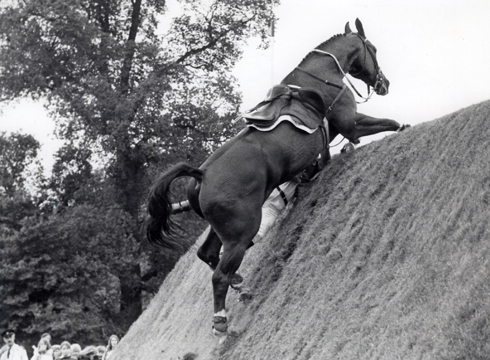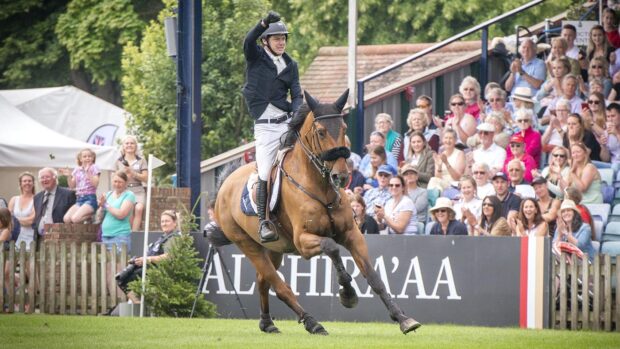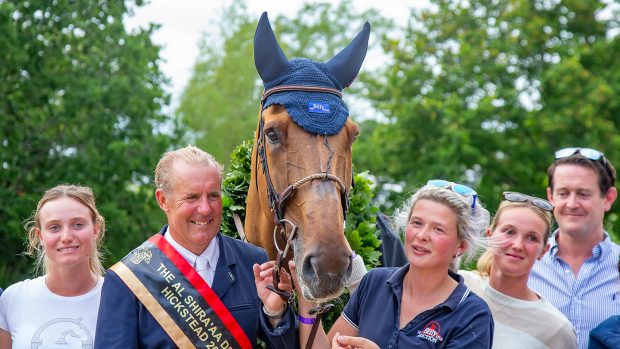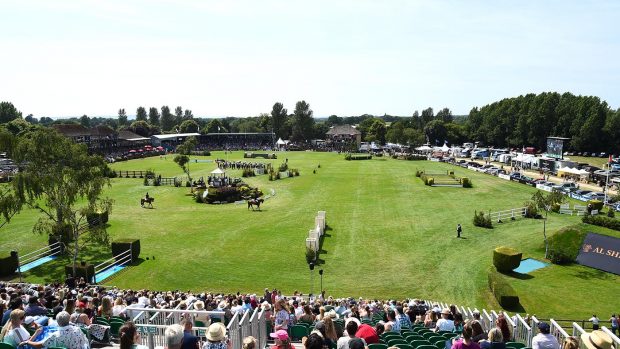Horse & Hound's coverage of The Equestrian.com Hickstead Derby Meeting (24-28 June) is brought to you in association with Equestrian.com
A lot has changed since the All England Jumping Course first opened its doors 55 years ago. Take a look back at the combinations that have shone in the Hickstead Derby during the past five decades — and find out what three-time Derby winner Capt John Ledingham makes of these legendary horses and riders.
1960s: Nelson Pessoa and Gran Geste (1963 and 1965)
Brazil’s Nelson Pessoa had his first win in 1963, in the 3rd running of the Hickstead Derby. The grey Gran Geste was by a Thoroughbred stallion out of a Brazilian native mare, and together he and Pessoa won everything from Grands Prix to Puissances and Derbies. In the first round in the 1963 Derby, the pair jumped everything clear aside from the smallest fence on the course, the rails on top of the Derby bank, but they were clear in the jump-off to claim the honours. 2 years later, the pair won the title for a 2nd time.
Capt John Ledingham: “Gran Geste was a real Grand Prix horse, at the top of his game. Here you can see Nelson is in superb balance coming down the Bank, and look at his position — it’s perfect, especially the lower leg. Pessoa was a purist, a classical horseman. Talent like that stands out a mile, even 50 years later.”
1960s: Marion Mould and Stroller (1967)
Marion Mould was just 20 years, 1 month and 10 days old when she won the Hickstead Derby, making her the youngest winner of all. Marion and Stroller were one of only 3 combinations in the history of the Derby to jump a clear round on 3 occasions (Apollo and Nick Skelton 1988, 1989, 1990; and Kilbaha and Captain John Ledingham in 1994, 1995 and 1998), but they only won it once, finishing second in 1964 and 1968, and third in 1970.
John: “Stroller was a 14.2hh pony with the heart of a lion and all the ability of a top horse. He was small in stature, but had a big stride, which helped him cope with the demands of the Derby course. In this photo, Stroller was sliding down the bank at an angle and Marion had to remain very still and allow him his head — they reached the bottom and were able to clear the huge upright 2 strides later. The fact he was vertically challenged didn’t mean anything to Stroller.”
1970s: Harvey Smith and Mattie Brown (1970 and 1971)
Mattie Brown was the first horse to win 2 consecutive Hickstead Derbies. Having won the Derby on him in 1970, Harvey Smith failed to bring the trophy back the following year — he claimed to have forgotten it; while Hickstead founder Douglas Bunn felt that Harvey was overconfidently presuming he’d win it straight back. Harvey duly won again for a second time, and famously flicked two fingers up in the direction of the Master’s Box.
John: “Harvey was an ultra-competitive rider, a proper horseman, a big, strong Yorkshireman. Mattie Brown was an Irish horse, unbelievably careful and nimble, but not super scopey. He was a naturally cautious horse, but Harvey would be there with a bit more leg, a bit more support, to give the horse confidence.”
1970s: Eddie Macken and Boomerang (1976-1979)
Irishman Eddie and Boomerang are the most successful combination in the history of the Hickstead Derby, winning 4 times in succession. At that time, Eddie was the highest ranked rider in the world, winning a host of Grands Prix around the world.
John: “Boomerang was a strong horse and didn’t really like going in a conventional bit. Eddie was one of the original promoters of the hackamore – they’d rarely been seen before that point. In every photo you see of Eddie, his position is just right. To me he’s one of the top 5 showjumpers of all time.”
1980s: Paul Schockemöhle and Deister (1982 and 1986)
Deister was a remarkable horse, winning the European championships 3 times in a row as well as team bronze at the 1984 Olympics. Paul was a businessman, working full-time and competing as an amateur – he would just turn up and ride. As well as his 2 Derby wins on Deister, Paul also won in 1985 riding Lorenzo, and he might have won the 1984 Derby as well had Deister’s bridle not broken in the jump-off.
John: “Deister had his own jumping style — most showjumpers are even off the floor, but Deister could twist through his back and tuck his hind legs underneath him. He was a horse who wanted to miss the poles, and he always knew where the top rail was. Here you can see he’s going in a combination of a hackamore and a bit — he was probably too strong in just a bit, but not strong enough for a hackamore. He was a tall, narrow horse, not a power house like Ryan’s Son.”
1980s: John Whitaker and Ryan’s Son (1983)
John and his brother Michael are both among the 4-time winners of the Derby. John’s 1st win came on Ryan’s Son, the beloved bay gelding who became his first international horse and probably second only to Milton in the whole of John’s career. Together, they medalled at the Olympics, the World and the European Championships.
John: “Ryan’s Son was a quality horse with unusual markings — Irish-bred, strong, and not as plain as his blaze would have you believe. He was quick, scopey and an incredible performer. As horsemen go, John’s at number one. His ability to analyse horses, especially difficult ones, and to keep older horses sound and fit and enthusiastic, is second to none.”
1990s: Michael Whitaker and Monsanta (1991-1993)
Michael had the first of his 4 Derby wins at the age of 20, riding Owen Gregory, and went on to win a further 3 times with Monsanta in the early 1990s. The horse was around 16 or 17 when he had the first of his Derby wins — no one knew for sure quite how old he was — jumping the only clear round. The following year they finished on 4 faults but still won, while in 1993, they were the only combination to jump 2 clear rounds to head the jump-off and claim the honours for a final time.
John: “Monsanta was another horse who was strong and didn’t like a bit, and Michael was one of the first riders after Eddie Macken to use a hackamore. The hardest part with a hackamore is to keep the horse in front of the leg, but Michael was incredible at this. He’s classical to the nth degree and incredibly accurate.”
1990s: John Ledingham and Kilbaha (1994 and 1995)
John had his 1st taste of Hickstead Derby success in 1984, winning on board Gabhran, and he had to wait another 10 years before winning 2 more Derbies on Kilbaha. The pair won a 2-way jump off both years, beating John Whitaker and Gammon in 1995. The following year, John Ledingham and John Whitaker both produced the only clears to go into a jump-off, but unfortunately Kilbaha slipped and knocked the first fence, denying them a 3rd win.
John: “Kilbaha was on many winning Nations Cup teams around the world. He was not an indoor horse, he loved big open spaces and Hickstead was tailor-made for him. He was the best horse I’ve ever sat on. He was careful, and you knew if you had a pole it was your fault. He had unbelievable trust in me. At that time, riders were allowed to compete in soft hats with military uniforms, but by the late 1990s that changed to uniform with a riding hat.”
Continued below…

The Hickstead Derby: fantastic archive moments to savour
From V-signs to veterans to pint-sized pony victories, the Hickstead Derby hasn’t been short of drama over the decades. Enjoy
2000s: Ben Maher and Alfredo (2005)
After Marion Mould and Michael Whitaker, Ben is the third youngest winner of the Hickstead Derby. He was just 22 when he rode the chestnut gelding Alfredo to victory in the 2005 Derby, having already won the Speed Derby the day before on Mercurius. A year before their win, Ben and Alfredo had left all the fences standing only to be kept out of the jump-off by 1 time penalty, and had to settle for third place. The following year, they joined Tim Stockdale and Cloudy Night in the jump-off, where a steady clear netted Ben the win.
John: “As you can see, by this decade, hats with a 3-point harness must be worn – the sport has got a lot more safety conscious. Ben Maher is the Eddie Macken of this decade. He’s a perfectionist, and very classical. Ben is a thinker, who has really worked on developing his talent, and fine tuning his skills. His lower leg is so secure, and you can see from this photo that his balance, suppleness and strength are superb.”
1990s: William Funnell and Cortaflex Mondriaan (2006, 2008 and 2009)
Sussex-based rider William Funnell had always wanted to win the Hickstead Derby, and he did so for the first time in 2006 on Cortaflex Mondriaan, following up with a further 2 wins in 2008 and 2009. William also came second in 2012 and 2013 on Dorada.
John: “Mondriaan was a big, scopey, warmblood, but perhaps not the most supple of horses. William was a very determined horseman, who was brought up close to Hickstead and reared on Derbies. It was his lifetime’s ambition to win it and once he did he couldn’t stop!”
2010s: Tina Fletcher and Promised Land (2011)
 Tina and Promised Land finished second behind Guy Williams in 2010, having jumped double clear, and when they went one better in 2011, Tina became the first woman to win the class since 1973. They missed out on the 2012 Derby, as Tina — who was later chosen as travelling reserve for the London Games — was busy aiming for Olympic selection with her top horse, Hello Sailor. Tina and Promised Land were hugely unlucky in 2013, when they were clear up until the Derby bank until the gelding stumbled slightly at the bottom of the bank and Tina was pitched out of the saddle.
Tina and Promised Land finished second behind Guy Williams in 2010, having jumped double clear, and when they went one better in 2011, Tina became the first woman to win the class since 1973. They missed out on the 2012 Derby, as Tina — who was later chosen as travelling reserve for the London Games — was busy aiming for Olympic selection with her top horse, Hello Sailor. Tina and Promised Land were hugely unlucky in 2013, when they were clear up until the Derby bank until the gelding stumbled slightly at the bottom of the bank and Tina was pitched out of the saddle.
John: “The open space of the Derby suited Promised Land as it gave Tina time to organise him. He is unusual in that his jump is not measured, it’s big and wild, the front end is open and the bascule is not the usual shape. He’s a lighter type, a real blood horse, with a lot of scope. He was quick through the air and slightly hollow in his jump — in this photo, at the double of ditches, Tina looks slightly behind the movement, which was probably a technique to restrain his exuberance and give him the time and space to jump out of the combination.”
2010s: Phillip Miller and Caritiar Z (2013)
The winner of the 53rd Hickstead Derby was Hertfordshire-based Phillip Miller, who learnt to ride at his local riding school and never left! He has ridden the grey gelding Caritiar Z, or ‘Carter’, since the horse was 5 and produced him up the levels. Last year, as well as winning the Derby, they also made their FEI Nations Cup debut for Great Britain at Lummen.
John: “Caritiar is a multi-talented horse, he can jump different types of courses on different surfaces, and he’s not just a Derby specialist. In this picture he’s showing a very good jumping technique, with his knees tucked under his chin, a perfect bascule and the rider in balance. He’s a lovely quality, modern stamp of a horse.”
Find out how you can get tickets for this year’s <a title=”Equestrian.com” href=”http://www.equestrian.com/” rel=”nofollow” Equestrian.com Hickstead Derby (25-28 June 2015)














